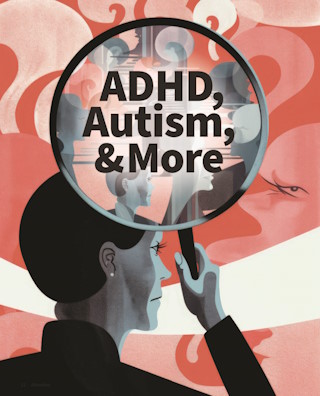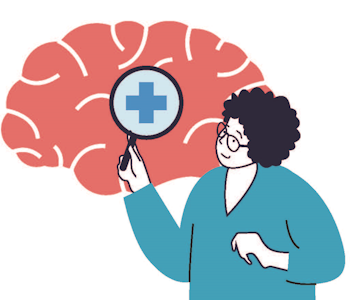ADHD, Autism, and More: What Goes into Getting a Diagnosis?
Sarah Cheyette, MD, and Benjamin Cheyette, MD, PhD
Download PDF
If you go to a doctor because you have an illness, the doctor will primarily rely on three things to diagnose you: the history (what you tell them about what you feel), an exam, and medical tests. Tests could include bloodwork, X-rays, MRIs, EKG, or other tests. Increasingly, doctors do DNA tests that contribute genetic information to the diagnostic process.

Tests are particularly helpful when the underlying biology of a medical condition is well understood. For example, doctors understand heart attacks pretty well. So they know what to look for on an EKG. They understand broken bones. They know what to look for on an X-ray. But doctors do not understand neuropsychiatric conditions well at all—and really, we have very poor ways of testing for them. This includes ADHD, but also autism spectrum disorder (ASD), depression, anxiety, and obsessive compulsive disorder (OCD).
Part of the reason is that neuropsychiatric disorders are generally not caused by a single abnormality, like the broken bone mentioned above. Instead, each of these disorders are (at least partly) caused by literally hundreds of genetic or biological variants. So the “gene” for ADHD is actually hundreds of genes. Each individual genetic change does not cause ADHD. However, in aggregate, a person with enough genetic variations may qualify for a diagnosis.
And it is not just the genetics! ADHD, ASD, and the other neuropsychiatric diagnoses have other contributors, too. Sometimes people develop these issues due to prenatal infection or other prenatal trauma, other medical issues after birth such as brain infections, malnutrition, physical and emotional trauma, environmental toxins (the list goes on)—and of course, interactions between all these factors, including genetics, put together.
Doctors really do not have the ability to see the different contributors to neuropsychiatric disorders on tests. So in a urinary tract infection, doctors can look under a microscope and see the little bacteria that caused it. There are not supposed to be bacteria and if there are—well that’s the problem, clearly. But we do not yet know all the genes that cause ADHD or other neuropsychiatric disorders. We can’t really measure stress and have only rudimentary ways to look at toxin exposure. It’s not so easy.
Diagnostic categories and criteria are evolving
 What do doctors have to go on? Although doctors can glean some information from a person’s behavior during the evaluation (are they pacing a lot? talking very quickly? hallucinating?), the main diagnostic test is the history offered to them by patients and their family. To make neuropsychiatric diagnoses, doctors ask about behavioral symptoms and then they categorize: If a patient has behavioral symptom A, behavioral symptom B, and behavioral symptom C, then (assuming the condition is severe enough) they qualify for the diagnosis of neuropsychiatric disorder X. The definition of neuropsychiatric disorder X has been agreed upon as a standard by a committee of professionals who have expertise in defining and treating it.
What do doctors have to go on? Although doctors can glean some information from a person’s behavior during the evaluation (are they pacing a lot? talking very quickly? hallucinating?), the main diagnostic test is the history offered to them by patients and their family. To make neuropsychiatric diagnoses, doctors ask about behavioral symptoms and then they categorize: If a patient has behavioral symptom A, behavioral symptom B, and behavioral symptom C, then (assuming the condition is severe enough) they qualify for the diagnosis of neuropsychiatric disorder X. The definition of neuropsychiatric disorder X has been agreed upon as a standard by a committee of professionals who have expertise in defining and treating it.
These behavioral diagnostic categories have been useful. For one thing, they have proved to be very handy for guiding appropriate clinical treatment, including both medication and non-medication treatments. So if you qualify for a neuropsychiatric diagnosis of ADHD, for example, we are pretty sure that medications for ADHD and behavioral strategies that address ADHD should help you. They are also a means of communication. If you have issues with inattention, impulsivity, and hyperactivity, then it’s a way of communicating to insurance companies, and school administrators—with a diagnosis, they know how to support you. Researchers use these diagnostic categories to come up with new ways to diagnose and treat the disorders, too.
However, a diagnosis based on history and observations of a person has limitations. One major limitation is that human behavior can never really be compartmentalized so neatly. For example, the genetics of ADHD suggest that people have a spectrum of attention issues. We diagnose ADHD based on a somewhat arbitrary cutoff. But there is not a clear difference in attention concerns between people at the lower end of “normal” attention and those who meet the criteria.
Also, the same symptoms can be found in different neuropsychiatric disorders. For example, one aspect of ADHD is that people have a hard time starting and completing tasks. People with depression also can have a hard time starting and completing tasks. People with anxiety can have a hard time starting and completing tasks. People with OCD can have a hard time starting and completing tasks. So the behavioral symptom—the hard time starting and completing tasks—can be a factor in different neuropsychiatric disorders.
As another example, there are several types of anxiety disorders that have been categorized, but the general condition of anxiety is found across many other behavioral disorders. So although ASD is not considered an anxiety disorder, people with ASD are often anxious. So are people with ADHD, as are people with migraines, asthma, cardiac arrhythmia, and so forth.
The criteria for diagnosis will continue to change as our understanding of the symptoms progresses. We expect that there will be more recognition of the overlapping symptoms as the understanding of the biologic mechanisms that underlie the symptoms are clarified.
So the diagnostic categories that doctors use as a main way of diagnosis of neuropsychiatric disorders are not so easily cataloged as medical books might tempt a person to believe. The categorization is a tool designed to organize human behavior in a clinically useful way—but it is inherently artificial, and must be taken with a grain of salt (and preferably used by a well-trained clinician with plenty of practical experience and good judgment).
Our diagnostic categories are also evolving. Every few years, there is reassessment of the diagnostic categories and changes are made. The diagnostic guidelines are distributed in a book called the Diagnostic and Statistical Manual, commonly referred to as the DSM. Up until 2014, the DSM guidelines stated that the diagnoses of ASD and ADHD were mutually exclusive. That is, if you have ASD then you couldn’t also be diagnosed with ADHD and vice versa. In the latest version of the DSM (the DSM-5-TR), however, co-diagnosis is allowed.
It is expected that the criteria for diagnosis will continue to change as our understanding of the symptoms progresses. We expect that there will be more recognition of the overlapping symptoms as the understanding of the biologic mechanisms that underlie the symptoms are clarified. One example is that mood regulation issues (anxiety, mood lability, depression) often seen in ADHD may one day be recognized as part of the diagnostic criteria for ADHD.
Understanding the overlap between ADHD and ASD
Let’s look further at the co-diagnosis of ADHD and ASD. On the basis of simple symptom categorization, there is a fair amount of overlap between these two behavioral conditions. Here are some statistics: There is a 5-10% incidence of ADHD overall in children, and a 2-5% incidence of ASD. Based on DSM-5 criteria, around 50% of children diagnosable with ASD could also be diagnosed with ADHD, and around 15% of children diagnosable with ADHD could also be diagnosed with ASD. So there is clearly an association that is higher than expected based on chance alone.
Why do these two disorders have so much overlap? The symptoms can look similar to observers. Both disorders make kids appear less engaged. Eye contact tends to be worse in both disorders. For a child with ADHD, the eye contact may be poor because their attention is grabbed by other items in the room, so they look from item to item. For an ASD child, poor eye contact may reflect an inability to socially connect, or possibly a fixation on aspects of other items in the room that neurotypical people don’t look at, such as shadows or lines. Inattentive behavior in ADHD may cause affected children to miss social cues, for example, which can resemble ASD, where social cues are not necessarily understood or given weight to. Kids with ADHD have a higher rate of rejection by their peers, which can lead to them being more withdrawn, which may also resemble ASD. Children with both disorders may have, or develop, problems with empathy.
Impulsive behavior and deficits in planning (executive functioning) are common to both disorders. Both disorders can include issues with expressive language. In both disorders there is a higher degree of what psychologists call behavioral rigidity. Learning disabilities in language or motor skills (for example, dyslexia) can be seen in higher frequencies in both ADHD and ASD. People with ASD and ADHD both have higher than average rates of depression and anxiety.
Research is pointing to underlying genetic or other biological factors common to both disorders. In many families where there is a child with ASD, there is a higher incidence of other family members who have ADHD (and vice versa). It’s possible that as many as two-thirds of the risk variants involved in each disorder are the same. Each individual variant does not change behavior much, but in aggregate many variants result in a behavioral syndrome we label with a diagnosis. If you have enough of these variants, whether you get ADHD or ASD may be random, or due to other factors. Perhaps if there are a few more variants in an ASD direction you are more likely to get ASD, and if there are a few more variants in an ADHD direction you are more likely to get ADHD—but in both cases it’s not all about genes: you can have all those variants and not get either disorder.
Researchers and effective treatments
Although we already mentioned that medical tests including brain MRIs are generally not helpful in making psychiatric diagnosis, at a research level some interesting differences and similarities have been found in specialized brain scans. Note that these differences are not generally discernable on a single scan and so are not very useful when examining an individual patient— this is research data averaged over hundreds or thousands of test subjects.
What the researchers have seen is a larger total brain and white matter volume in some people with ASD, but not ADHD. On the other hand, in both disorders a smaller corpus callosum (a connection between the right and left hemispheres of the brain) has been found in some patients. There are other types of scans called functional neuroimaging, like functional MRI, SPECT, or PET scans. In these types of scans, different parts of the brain “light up” depending on the rate of metabolism while a person performs a wide range of tasks. The most consistent finding in both disorders is reduced activation of front and side brain regions (the frontal and parietal lobes).
Effective behavioral treatments for the two disorders also have some similarities and some differences. In ASD the major goal is usually to promote social skills development, whereas in ADHD the major goal is usually on managing executive tasks. However, controlling impulsive behavior is often a therapeutic focus in both disorders. Many of the therapeutic techniques used in each disorder are similar. For example, the positive reinforcement of desired behaviors, achieving consistent quality sleep, engaging in regular exercise, and assembling appropriate educational support are important strategies for treating both ADHD and ASD.
There is also overlap in the medications used to treat these two disorders. As with behavioral treatment, medication management focuses on targeting specific symptom improvement. So whether your child has ASD or ADHD, if the goal is to improve attention, a medication that has been FDA-approved for attention (ADHD) may be helpful. Conversely, there are some medications that have been FDA-approved for impulsive behaviors such as aggression in ASD. Although less common, these medications may sometimes be useful for impulse control in severe ADHD. Medications for anxiety and depression might help either condition.
Focus on treating actual challenges more than a diagnosis
In summary, if you or your child has been given a diagnosis of ADHD or ASD or any combination thereof, focus on treating actual behavioral challenges more than a diagnosis listed in a book or on a website. If your child has specific challenges with hyperactivity and/or impulsivity, then look for behavioral strategies or medications to address that particular problem. If social skills training is needed, focus on that. Treatment must always be based on what’s in the best interest of the patient—who is an individual with an individualized behavioral condition, not a categorical diagnosis in a book.
We believe that in the future, there will be more objective testing for ADHD, ASD, and other neuropsychiatric disorders. One exciting new area that is developing are devices such as eye tracking devices or virtual reality headsets, that may also show important similarities and differences in what we now consider different diagnoses. Genetic tests are on the horizon (but not here yet) as well.
It’s possible that the way we define these disorders to date, mainly getting a history from the patient and family, will be looked upon by future doctors as primitive. The doctors of the past who diagnosed based on “humors” had treatments such as bloodletting and leeches, but those were the cutting-age technology of the day. Doctors do the best we can with the information we have, but acknowledge humbly that we need more.
 Sarah Cheyette, MD, graduated cum laude in cognitive neuroscience from Princeton University and received her medical degree from the UCLA David Geffen School of Medicine. Following specialty training in pediatrics at Cedars-Sinai Medical Center in Los Angeles and in pediatric neurology at Seattle Children’s Hospital, she settled with her family in the San Francisco Bay Area. She practices at the Palo Alto Medical Foundation, where she focuses on treating ADHD in both children and adults. She is the author of three books on ADHD: ADHD and the Focused Mind, Winning with ADHD, and ADHD & Me, as well as a book on headaches, Mommy My Head Hurts.
Sarah Cheyette, MD, graduated cum laude in cognitive neuroscience from Princeton University and received her medical degree from the UCLA David Geffen School of Medicine. Following specialty training in pediatrics at Cedars-Sinai Medical Center in Los Angeles and in pediatric neurology at Seattle Children’s Hospital, she settled with her family in the San Francisco Bay Area. She practices at the Palo Alto Medical Foundation, where she focuses on treating ADHD in both children and adults. She is the author of three books on ADHD: ADHD and the Focused Mind, Winning with ADHD, and ADHD & Me, as well as a book on headaches, Mommy My Head Hurts.
 Benjamin Cheyette, MD, PhD, is a board certified psychiatrist who treats a wide variety of patients, including those with depression and adult ADHD. Dr. Cheyette is the director of ADHD services at Mindful Health Solutions. He is a professor emeritus at University of California San Francisco, and previously served as director of the UCSF Psychiatry Consult-Liaison Service, the UCSF Molecular Medicine Pathway, and NIH-funded research into animal models of neuropsychiatric illness.
Benjamin Cheyette, MD, PhD, is a board certified psychiatrist who treats a wide variety of patients, including those with depression and adult ADHD. Dr. Cheyette is the director of ADHD services at Mindful Health Solutions. He is a professor emeritus at University of California San Francisco, and previously served as director of the UCSF Psychiatry Consult-Liaison Service, the UCSF Molecular Medicine Pathway, and NIH-funded research into animal models of neuropsychiatric illness.
Other Articles in this Edition
Hope and Help for Anxious Kids
How to Recover After a Social Faux Pas
Physiological and Emotional Awareness in Individuals with ADHD
ADHD, Autism, and More: What Goes into Getting a Diagnosis?
Executive Function Coach: A Personal Trainer for Your Child’s Brain
Eight Tips for Successful ADHD Family Travel
Why ADHD Is More Challenging for Women
Successfully Delegating Written Projects
